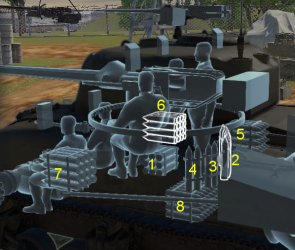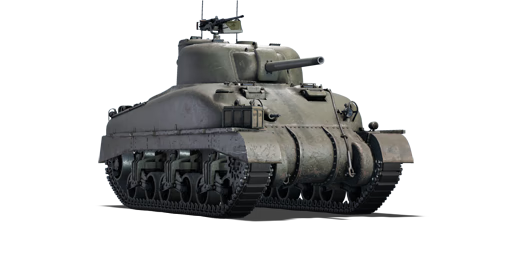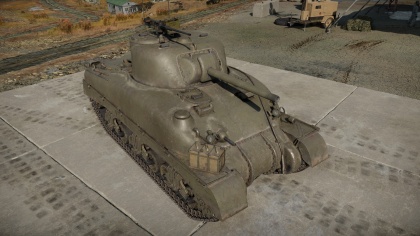Sherman II
Contents
| This page is about the British medium tank Sherman II. For the British tank with a similar name, see Sherman Firefly. For other uses, see M4 (Disambiguation). |
Description
The Sherman II is a Rank British medium tank
with a battle rating of (AB), (RB), and (SB). It was introduced in Update 1.65 "Way of the Samurai". The Sherman II is the designation of the American M4A1 Sherman and is fitted with a 75 mm gun with access to APCR ammunition.
The Sherman II is basically a M4A1 Sherman, to which users of it in the American ground forces tree will be very familiar with. Almost everything with it is identical with the American version, however the Sherman II has access to the T45 APCR ammunition. This tank play style is one maximizing the -12° gun depression in hull-down positions and its very good automotive performances to travel with blistering speed on the battlefield to attack the enemy from a place they wouldn't expect.
General info
Survivability and armour
Armour type:
- Cast homogeneous armour
- Rolled homogeneous armour (Lower side hull)
| Armour | Front (Slope angle) | Sides | Rear | Roof |
|---|---|---|---|---|
| Hull | 38.1-50.8 mm (48°-72°) Front glacis 50.8 mm (11-58°) Transmission area |
38.1 mm (1-71°) Top 38.1 Bottom |
38.1 mm (0-69°) Top 38.1 mm (13-51°) |
19.5 mm |
| Turret | 76.2 mm (2-66°) Turret front 50.8 mm (3-49°) Gun mantlet |
50.8 mm (0-65°) | 50.8 + 4 mm (0-60°) | 25.4 mm |
| Armour | Sides | Roof | ||
| Cupola | 50.8 mm | 25.4 mm |
Notes:
- Suspension wheels are 15 mm thick, bogies are 10 mm thick, and tracks are 20 mm thick.
- Sand skirts on the suspension sides are 4 mm thick.
- Front armour slope not even, lower part is weaker than top.
- A small patch on the turret front right side is thinner (50.8 mm) than the rest (76.2 mm).
- Bolt edges on the transmission housing are 101.6 mm thick.
Mobility
| Mobility characteristic | ||
|---|---|---|
| Weight (tons) | Add-on Armor weight (tons) |
Max speed (km/h) |
| 30.6 | N/A | 42 (AB) |
| 38 (RB/SB) | ||
| Engine power (horsepower) | ||
| Mode | Stock | Upgraded |
| Arcade | 620 | 763 |
| Realistic/Simulator | 354 | 400 |
| Power-to-weight ratio (hp/ton) | ||
| Mode | Stock | Upgraded |
| Arcade | 20.26 | 24.93 |
| Realistic/Simulator | 11.57 | 13.07 |
Armaments
Main armament
| 75 mm M3 | |||||
|---|---|---|---|---|---|
| Capacity | Vertical guidance |
Horizontal guidance |
Horizontal guidance | ||
| 90 | -12°/+18° | ±180° | Vertical | ||
| Turret rotation speed (°/s) | |||||
| Mode | Stock | Upgraded | Prior + Full crew | Prior + Expert qualif. | Prior + Ace qualif. |
| Arcade | 22.85 | 31.62 | __.__ | __.__ | 45.18 |
| Realistic | 14.28 | 16.80 | 20.4 | 22.60 | 24.00 |
| Reloading rate (seconds) | |||||
| Stock | Prior + Full crew | Prior + Expert qualif. | Prior + Ace qualif. | ||
| 6.50 | 5.75 | 5.30 | 5.00 | ||
Ammunition
| Penetration statistics | |||||||
|---|---|---|---|---|---|---|---|
| Ammunition | Type of warhead |
Penetration in mm @ 0° Angle of Attack | |||||
| 10m | 100m | 500m | 1000m | 1500m | 2000m | ||
| M72 shot | AP | 90 | 88 | 78 | 66 | 57 | 49 |
| M48 shell | HE | 10 | 10 | 10 | 10 | 10 | 10 |
| M61 shot | APCBC | 103 | 101 | 90 | 78 | 67 | 59 |
| T45 shot | APCR | 143 | 137 | 127 | 106 | 86 | 70 |
| Shell details | ||||||||||
|---|---|---|---|---|---|---|---|---|---|---|
| Ammunition | Type of warhead |
Velocity in m/s |
Projectile Mass in kg |
Fuse delay
in m: |
Fuse sensitivity
in mm: |
Explosive Mass in g (TNT equivalent): |
Normalization At 30° from horizontal: |
Ricochet: | ||
| 0% | 50% | 100% | ||||||||
| M72 shot | AP | 619 | 6.30 | N/A | N/A | N/A | -1° | 47° | 60° | 65° |
| M48 shell | HE | 463 | 6.30 | 0.4 | 0.5 | 666 | +0° | 79° | 80° | 81° |
| M61 shot | APCBC | 618 | 6.79 | 1.2 | 20 | 63.7 | +4° | 48° | 63° | 71° |
| T45 shot | APCR | 868 | 3.81 | N/A | N/A | N/A | +1.5° | 66° | 70° | 72° |
| Smoke characteristic | ||||||
|---|---|---|---|---|---|---|
| Ammunition | Velocity in m/s |
Projectile Mass in kg |
Screen radius in m |
Screen time in s |
Screen hold time in s: |
Explosive Mass in g (TNT equivalent): |
| M89 | 259 | 3 | 13 | 5 | 20 | 50 |
Ammo racks

| Full ammo |
1st rack empty |
2nd rack empty |
3rd rack empty |
4th rack empty |
5th rack empty |
6th rack empty |
7th rack empty |
8th rack empty |
Visual discrepancy |
|---|---|---|---|---|---|---|---|---|---|
| 90 | 79 (+11) | 67 (+23) | 56 (+34) | 45 (+45) | 34 (+56) | 23 (+67) | 12 (+78) | 1 (+89) | Yes |
Turret empty: 45 (+45)
Machine guns
| 12.7 mm M2HB | ||||||
|---|---|---|---|---|---|---|
| Pintle mount | ||||||
| Capacity (Belt capacity) | Fire rate (shots/minute) |
Vertical guidance |
Horizontal guidance | |||
| 600 (200) | 577 | -10°/+22° | ±60° | |||
| 7.62 mm M1919A4 | ||||||
|---|---|---|---|---|---|---|
| Coaxial mount | ||||||
| Capacity (Belt capacity) | Fire rate (shots/minute) |
Vertical guidance |
Horizontal guidance | |||
| 3,000 (250) | 500 | N/A | N/A | |||
Usage in battles
The best use of the Sherman II is in a defense or an exploitation movement.
In the defense: hull-down position. Find a terrain like a hill where the Sherman can inch forward, exposing only the turret, yet be able to aim down most of the horizon with the 75 mm gun. This allows the Sherman to use the most of the turret and gun mantlet armour as well as minimizing the amount of the body able to be hit by incoming enemy fire while dishing out quite a considerable amount of fire towards the enemy with a fast-firing 75 mm gun. If enemy fire at the hull-down position intensify or wound the crew members, simply reversing can put the Sherman in adequate cover and reposition for another attempt to attack the enemy.
In exploitation, attack enemy utilizing the Sherman's adequate speed and handling. Maneuver into enemy territory scanning for targets. A benefit of the fast reloads and the traverse rate of the Sherman is that it allows for quick reaction to enemies spotted at various directions. Remember that in general rule of tank combat, the first person to shoot generally wins the battle. As such, it is imperative for the success of this tactic to attack an enemy not aware of the Sherman's presence and movement. As such, an unaware enemy will probably be exposing their weak points such as the side armour, allowing for a well-placed 75 mm shot to damage the interior. Try not to be caught up in one position as being stuck in one place will cause the enemy to eventually swarm the Sherman and destroy it.
Pros and cons
Pros:
- Access to APCR ammunition
- Very fast turret traverse speed
- Very good gun depression -12°
- Very mobile once acceleration kicks in
- Pintle-mounted HMG provides anti-aircraft defense
- Fitted with a vertical stabilizer, allowing more accurate fire on the move compared to other tanks, as well as better usage of shoot-n-scoot tactics
- One of the very few British vehicles with explosives in APCBC-rounds
- Round with explosive filler are extremely effective against Panzer III and IV tanks
- Turret is well armoured from the front. Works well in Hull down positions.
Cons:
- Thin 50.8 mm front armour
- Armour is not as strong against upgunned vehicles like the Panzer IV F2 and the T-34 mod.1942
- Faces some very strong opponents in up-tiered matches.
- Weak side armour. It is flat and can be penetrated by German and Russian SPAA.
- Narrow tracks offer poor ground flotation, thus poor off-road capabilities
- Prone to damage by artillery barrages, tracks can be hit and fuel supply can be ignited
- Can only reach its top speed on paved or hard surfaces
- Ammunition storage is vulnerable to cooking off
- May tip over when travelling across steep inclines
- A shot through hull vision blocks can set off turret's ammo supply and hull sponson ammo and a lucky shot might even knock the tank out
History
Development
The Battle of France in 1940 proved to America that their current tank arsenal would not be able to withstand a German assault. The only tanks in their inventory at that time was the M2 Light Tanks and the M2 Medium Tank, both are inadequate against the German Panzer IIIs and the Panzer IVs. The US Army, in response, ordered for a tank armed with a 75 mm gun. While a 75 mm gun was available for use, a turret able to mount the gun was not. So while the turret and tank design underwent development, the 75 mm would be mounted on the stopgap design, the M3 Lee tank in a sponson mount. This interim design put the 75 mm on a lower and limited traverse mount that restricted its firing angle, but it did give the Allies a tank with the gun, so it was issued by the thousands until a better design could be made.
During the M3's development, the designs of the 75 mm armed vehicle were being drawn up and submitted by the Ordnance Department. Specifications on the tank design were strict in order to maximize logistical support. Restrictions were made on the tank's height, width, and weight in order to make it able to be transported over bridges, roads, railroads, and on naval ships. These specifications would help the Army by making the tank be very flexible on strategic, logistical, and tactical grounds. On April 1941, the Armored Force Board chose the simplest of the designs, which was a redesigned M3 hull and chassis with a turret mounting the 75 mm gun designated the T6, completed in September 1941. This tank would then designated the Medium Tank M4 in American service. The tank would eventually become the most used Allied tank during World War II as it was lended out by the thousands in the Lend-Lease program to the Allied countries. The British called the M4 the "Sherman", which coined into the tank's name M4 Sherman that it would be known as in history. The production for the Shermans began on October 1941 and would continue to be produced until the end of the war in 1945 with around 50,000 units produced, making it the second most-produced tank in World War II before the T-34 tank.
Design
Many variants of the Shermans were produced, but they all followed a similar layout. The driver and bow gunner sat in the front driving compartment, the fighting compartment in the middle housed the turret its three crew member, and in the back was the engine compartment. The Sherman used many features present in previous American tank designs, the vertical volute suspension system (VVSS) and radial engine from the M2 Light Tanks, and the sloping armour of the M2 Medium Tanks. This became a contributing factor on the Sherman's reliability on the field, as most of the design flaws were ironed out with the previous tank designs. The tank mounted the 75 mm M3 gun, giving the tank very good AP and HE capabilities. The Sherman's turret traverse speed was very fast, able to traverse a full 360 degrees in only 15 seconds, which is considerably faster than the traverse speed on most German tanks. Another unique feature on the Sherman was the installation of a gyroscopic stabilizer on the gun and sight, making the Sherman one of the first produced tanks to incorporate those features. While the stabilization was only done for the vertical plane, it kept the gun stable enough to be able to shoot on the move effectively, with a study showing a 70 % hit probability on an enemy 300 to 1,200 yards away when moving at a speed of 15 mph. However, this feature was controversial among the crew and experiences with it vary.
The M4A1 Sherman model (known in British nomenclature as the Sherman II) ran on a gasoline Continental R975C-1 radial engine and was one of the first models of the Sherman developed. The model in-game features the early M38 telecopic sight in the M4 periscope with no zoom, which was later replaced with a M55 telescopic sight in the gun mantlet by recommendation from the British.[1] The tank's hull was fully cast, giving the tank a distinctive rounded slope front and sides. Though the rounded shape gave the frontal armour uneven angling, it provided adequate protection up to 100 mm in thickness in certain areas. Cast armour was used because casting took less man hours to perform, but suffered from the limited capability of most American factories and was hard to repair on the field. Thus, welding was prioritized as the primary manufacturing method in the other Sherman variants.[2] Nevertheless, up to 6,281 M4A1s were produced from February 1942 to December 1943, out of the 49,234 Sherman units produced in the war.
British nomenclature
The British had a different naming convention with their equipment than the Americans. It is this naming system that actually gave the M4 Medium tank their namesake "Sherman". As the American differentiate the M4 models with letter and numbers such as M4, M4A1, M4A2, and M4A3. The British use roman numerals past the name "Sherman". Thus, the nomenclature translate to:
- Sherman I - M4
- Sherman II - M4A1
- Sherman III - M4A2
- Sherman IV - M4A3
- Sherman V - M4A4
- Sherman VII - M4A6
Past these designation, there would be a letter to signify differences in model design. A designation ending with "A" indicates the usage of the 76 mm gun. A designation ending with "B" indicates the usage of the 105 mm howitzer. A designation ending with "Y" would indicate the usage of the Horizontal Volute Suspension System (HVSS). Finally, a designation ending with "C" indicates the usage of the 17-pdr gun, essentially translating to the Firefly. There was a word addition "Hybrid" exclusive to the Sherman I variant, meaning the M4 Hybrid design which used a cast front armour, but a welded rear design.[3]
Media
An excellent addition to the article will be video guides, as well as screenshots from the game and photos.
References
- ↑ Zaloga Steven. Armored Thunderbolt: The U.S. Army Sherman in World War II Stackpole Books, 2008, "Baptism Of Fire"
- ↑ Zaloga Steven. Armored Thunderbolt: The U.S. Army Sherman in World War II Stackpole Books, 2008, "The School of Tank Technology"
- ↑ Christopher John. Sherman M4 Medium Tank Amberley Publishing, 2014
See also
- M4A1 - American equivalent of the Sherman II.
- A1E1 Independent - The only other tank in the British tech tree with AP-HE ammunition.
External links
Paste links to sources and external resources, such as:
- topic on the official game forum;
- encyclopedia page on tank;
- other literature.
| Britain medium tanks | |
|---|---|
| Valentine | Valentine I · Valentine IX · Valentine XI |
| Cromwell | Cromwell I · Cromwell V · Cromwell V (RP-3) |
| Cromwell derivatives | Challenger · Avenger · Comet I · Comet I "Iron Duke IV" · Charioteer Mk VII |
| Centurion | Centurion Mk 1 · Centurion Mk.2 · Centurion Mk 3 · Centurion Mk.5 AVRE · Centurion Mk 10 · Centurion Action X · FV4202 |
| Vickers MBT | Vickers Mk.1 · Vickers Mk.3 · Vickers Mk.7 |
| Chieftain | Chieftain Mk 3 · Chieftain Mk 5 · Chieftain Mk 10 |
| Challenger 1 | Challenger Mk.2 · Challenger Mk.3 · Challenger DS |
| Challenger 2 | Challenger 2 · Challenger 2 (2F) · Challenger 2 TES · Challenger 2 OES · Challenger 2E · Challenger 2 Black Night |
| Challenger 3 | Challenger 3 TD |
| Australia | A.C.I · A.C.IV · Centurion Mk.5/1 |
| South Africa | Olifant Mk.1A · Olifant Mk.2 · TTD |
| India | Vijayanta · Bhishma TWMP |
| Israel | ▄Sho't Kal Dalet |
| Jordan | Khalid |
| Sweden | ▄Strv 81 (RB 52) |
| USA | Grant I · Sherman II · Sherman Firefly · Sherman IC "Trzyniec" |





